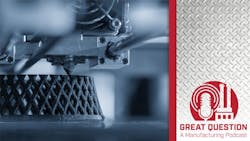Podcast: Has additive peaked or is the marketplace for 3D manufacturing simply shifting?
What you'll learn from this episode:
- Additive manufacturing hit $21.9 billion in 2024, with materials seeing the strongest growth—signaling broader industrial adoption.
- China doubled AM machine exports in two years, now leading global growth with rapid expansion into consumer and electric vehicle applications.
- U.S. AM growth is driven by government funding and reshoring efforts, with support from programs like AM Forward and America Makes.
- Material and software segments grew, but machine OEMs saw decline—highlighting a shift toward optimizing existing AM capabilities.
About the Podcast
Great Question: A Manufacturing Podcast offers news and information for the people who make, store, and move things and those who manage and maintain the facilities where that work gets done. Manufacturers from chemical producers to automakers to machine shops can listen for critical insights into the technologies, economic conditions, and best practices that can influence how to best run facilities to reach operational excellence.
The future of additive manufacturing/3D printing has, it’s fair to say, befuddled market observers and stakeholders for going on two years now—since merger and acquisition valuations flew through the roof shortly after COVID but have since come way down into perhaps semi-realistic territory.
Case in point: Israel-based Nano Dimension, the AM and 3D printing specialist that focuses on electronics, earlier this month finalized its imposed-by-a-Delaware court acquisition for $179.3 million of U.S.-based Desktop Metal, the AM manufacturer that specialized in 3D metal printing.
While $179.3 million is nothing to sneeze it, that pales in comparison to the $1.8 billion (that’s billon with a “b”) that Stratasys, the largest company in the AM space, bid less than two years ago for the very same Desktop Metal, which ironically may be split up for scrap now that Nano Dimension has completed the ins-and-outs of the deal.
See also: Nano Dimension wraps acquisition of Desktop Metal | Plus a timeline of recent AM events
We’ll know more about that (maybe) as soon as April 30, when Nano Dimension’s board is scheduled to meet to decide what it plans to do with Desktop Metal.
Generally speaking, private equity money allowed AM equipment companies to chase market share instead of profits for several years, but lately private cash infusion has soured on additive and companies were left to figure out how to translate market share into profits. This partly explains why Desktop Metal was worth a lot less today than Stratasys envisioned in just 2022 or 2023.
Podcast: Arming frontline workers with AI tools that work
We look for wise voices for our podcasts to bring clarity in marketplace situations such as the one that additive finds itself in—and we found one in perhaps the likeliest of all places, Wohlers Associates, an ASTM International company that collectively has been a longtime observer of the AM/3D printing marketplace and for 30 years has published its Wohlers Report, the 2025 version of which debuted earlier this month.
That voice, Mahdi Jamshid, director of market intelligence at Wohlers, joined Smart Industry’s Scott Achelpohl for a 30-plus-minute discussion recently.
Regarding the “inflated” valuations post-COVID for M&A in the additive space, he noted during the podcast that “now, that easy money is gone" and that the AM market “got a little too obsessed with the technology itself."
See also: Too many options on the table: How manufacturers can break free from digital inertia
But right now, he said, the focus is on what additive and 3D printing can—and cannot—do and where it can be applied, including regions of the world such as Asia (and China itself) where use of the tech is seen by the Wohlers Report as surging. Overall, the 2025 report saw topline value worldwide for AM of $21.9 billion in 2024, a healthy number and 9.1% increase over the previous year.
By no means, Jamshid stressed, is AM depressed or cratering, despite the impression the Nano Dimension-Desktop Metal merger might leave. Instead, use is shifting by region, manufacturers are more realistic about applications for the technology, and the U.S. is home to a lot of the market and the machines (the largest installed base) themselves.
But we won't steal his thunder; just check out this episode of Great Question: A Manufacturing Podcast for all the latest granular detail about additive manufacturing.
Below is an excerpt from this podcast:
Scott Achelpohl: Just a little information about Mahdi’s company, Wohlers Associates: a veteran observer of AM, they recently put out the latest version—for 2025—of the Wohlers Report, which had some interesting findings about the current strengths and weaknesses of additive manufacturing.
He’ll share some top-line findings from the report during our podcast today, add some perspective about the Nano Dimension-Desktop Metal deal, and we'll have some overall observations about the AM marketplace.
The new Wohlers Report had a top-line number worldwide for additive manufacturing of $21.9 billion in 2024, a 9.1% increase over 2023. I'm looking forward to Mahdi providing more detail, and I’m sure he'll help us really get into the weeds about what's happening with AM—a lot of people in manufacturing are asking. So, without further hesitation, let me introduce Mahdi, who has some opening remarks to kick off our discussion here on Great Question: A Manufacturing Podcast.
See also: How manufacturers are closing high-skill gaps
Mahdi Jamshid: Hey, Scott. Thanks so much for the invitation and also the great introduction. And you're right—we recently published the Wohlers Report 2025 almost a month ago, marking the 30th anniversary of this major milestone for us.
Beyond the historical significance, this year was particularly important because it was the first time ASTM took full ownership of the report development. That meant introducing much more global transparency, quality control, and also closer alignment with industry needs.
On that last point, we wanted to make sure what goes into the report is the type of information that is relevant to the current needs of the industry—what additive manufacturing stakeholders can use to make business decisions.
At the highest level, this is a 500-page document with six chapters. Chapter 1 focuses on market performance, forecasts, and analysis—a lot of charts, a lot of data. Then Chapters 2 through 6 are individual industries, regional investment, research and development, and over 40 country reports.
Video: How John Deere deployed 5G in a cutting-edge manufacturing advancement
This report was put together with the help of 40 of my colleagues—mainly for the quality control aspect—and contributions from 230 external AM experts. I'm so grateful for all the support they provided.
When it comes to additive manufacturing in 2024, our analysis suggests a 9.1% growth over 2023, reaching around $22 billion. Obviously, performance varied by segment. Segments such as software, printing services, and materials all showed positive revenue growth, but machine OEMs experienced a slight decline of about 2%.
One key observation was the growth of the materials sector—the strongest growth—with a little over 20%. That’s an indication of continued adoption. So it's true that end users or service providers are not necessarily purchasing the latest and greatest machines, but they are purchasing a lot more materials—which indicates continued adoption.
One last point about the market’s performance at the highest level: from the regional perspective, Europe and the Middle East saw modest positive growth; the Americas were slightly negative, but both within about ±5%. Last but not least, Asia-Pacific, especially China, led the way with growth just over 30%. There's a range of reasons for this significant growth, which we can get into if you want, Scott.
SA: Sure, Mahdi, that's great context. That said, let's get to some questions about additive manufacturing and how we should view it. Mahdi, can you provide a high-level overview of the additive industry at the global scale right now? In different countries, I know your report lays out that certain countries are performing differently, and certain regions of the world are performing differently than others. Can you just give us a brief overview of that?
MJ: One way to look at the global AM landscape is just by tracking machine installations—basically, how many machines have historically been installed in certain regions. This is the type of data we’ve been tracking for several years.
See also: Leading cyberattack against manufacturing sets record in Q1
At the continental perspective—from three regional perspectives that I mentioned earlier—North America is still in the lead, followed by Europe and Asia-Pacific.
But when we double-click and zoom into the country level, the U.S. has by far the largest installed base. In the past, Germany and Japan used to be in second and third place, but recently China has surged into No. 2.
There's one more important factor: It’s not just about the number of machines, but also about the kinds of machines—the models—that are being added. The new machines are typically faster, more productive, with bigger build volumes, higher performance, and higher quality.
Countries investing in next-generation equipment are positioning themselves for a much bigger share of the AM industry in the coming years. I wouldn’t be surprised if China’s share keeps going up in future years.
About the Author
Scott Achelpohl
Head of Content
I've come to Smart Industry after stints in business-to-business journalism covering U.S. trucking and transportation for FleetOwner, a sister website and magazine of SI’s at Endeavor Business Media, and branches of the U.S. military for Navy League of the United States. I'm a graduate of the University of Kansas and the William Allen White School of Journalism with many years of media experience inside and outside B2B journalism. I'm a wordsmith by nature, and I edit Smart Industry and report and write all kinds of news and interactive media on the digital transformation of manufacturing.

